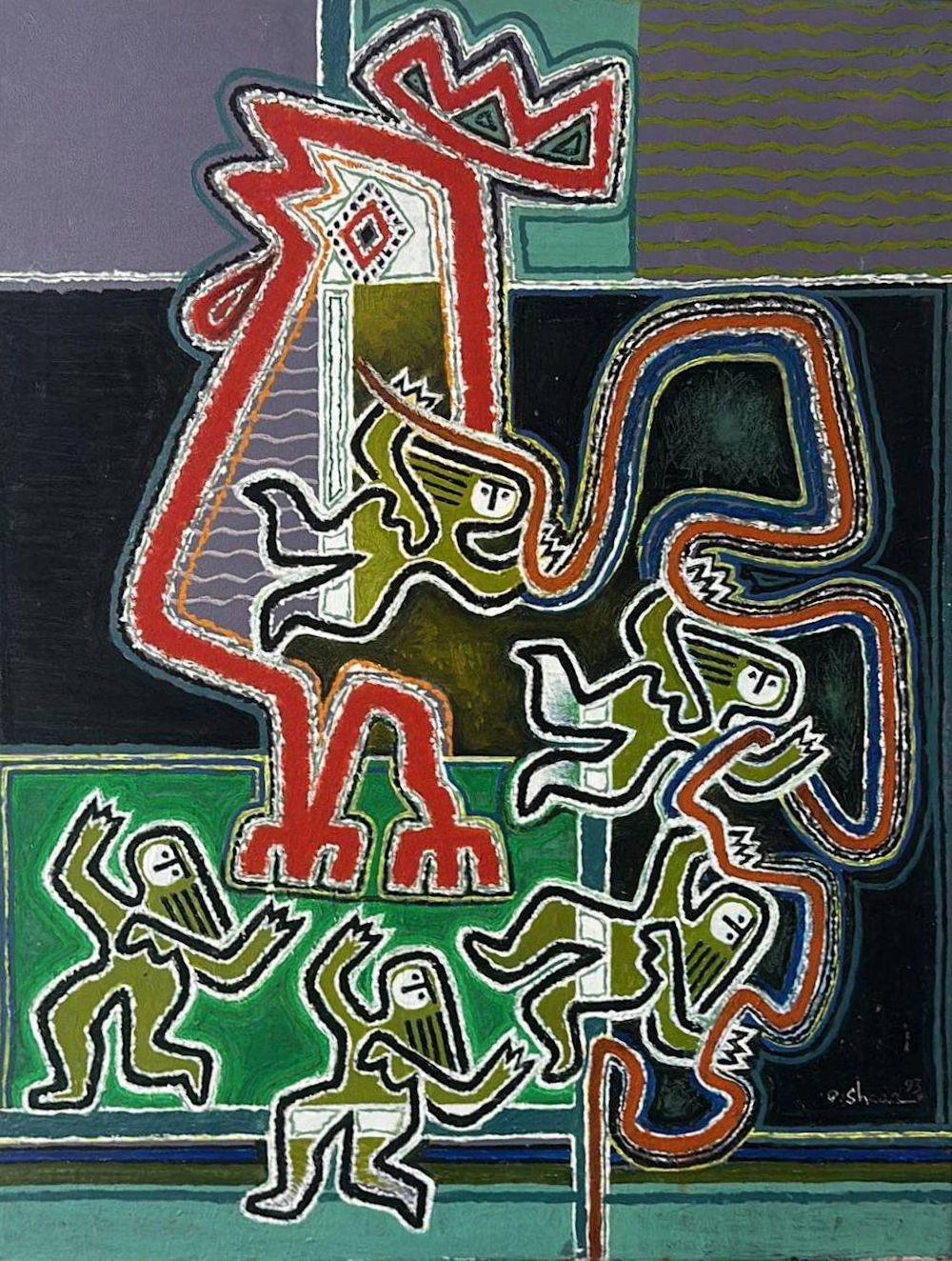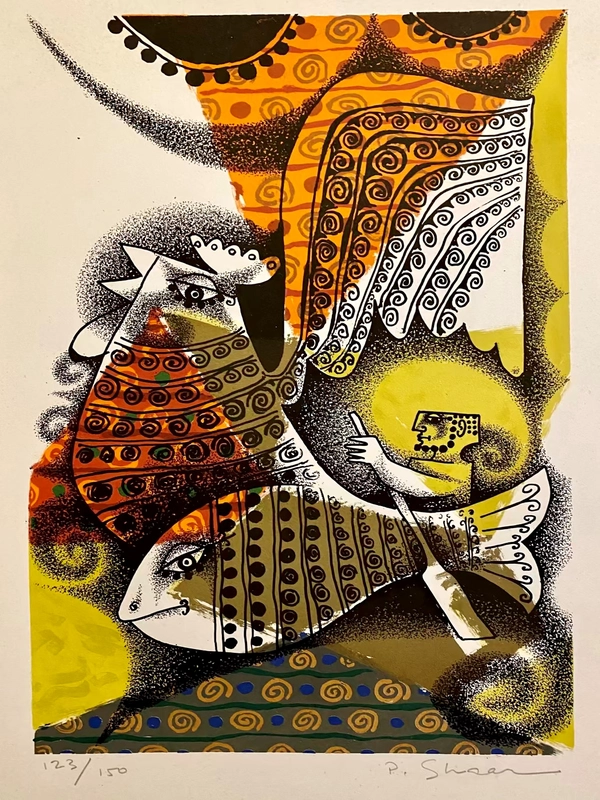Pinchas Shaar was an outstanding artist with an inimitable artistic voice – not just in a national perspective, but in a global one, as well. Today, as we celebrate the 100th anniversary of his birth, this exhibition at the Moshe Castel Museum of Art in Ma’ale Adumim serves to remind us of one of the most original, brilliant, and unique artists to have ever worked in Israel. Pinchas Shaar, a Holocaust survivor who had lived through the hell of the Łódź Ghetto, was able to transcend his tragic life story in his art, leaving behind a legacy of amazing artworks that are brimming with joy and hope.
Pinchas Shaar was born as Pinchas Schwartz on March 15, 1923, in the city of Łódź, Poland; he was the third of four children. Pinchas began to draw from a young age; in 1939, his works were exhibited for the first time, as part of a group exhibition.
After the Nazi invasion of Poland Pinchas Schwartz and his family were now incarcerated in the Łódź ghetto, together with some 200,000 other Jews, who suffered from malnutrition, hard labor, abuse, looting, and even executions on trumped-up charges. Already in the early months of 1942, some 20,000 Jews from Łódź were sent to the Chełmno extermination camp and gassed to death. On August 2, 1944, the first train to Auschwitz departed from the Radegast railway station. That month thousands of the ghetto inmates, including Pinchas' elder sister Esther, and her 1.5-year-old son Gershon, were murdered at Auschwitz. On January 19, 1945, when the Soviet army liberated Łódź, only about 10,000 of the 204,000 Jews survived. The Schwartz brothers and their father were among these survivors.
After their liberation, Pinchas, his brothers, and father decided to return to Łódź, arriving there on May 8, 1945. Several weeks later, they were surprised to meet the mother of the family, Chaya Feiga. Despite becoming severely emaciated, she had survived Ravensbrück – the largest German concentration camp for women. Like many other survivors, the Schwartz family felt that they could not remain in Poland.
In November 1947, Pinchas, who had far-reaching artistic ambitions, arrived to Paris in order to study at the Académie de la Grande Chaumière. In 1953, his first solo exhibition in France was held at the Galerie Saint-Placide. He spent more than a decade in that country – until 1958, when he immigrated to Israel, which he had first visited in 1949. There, he changed his last name to Shaar.
In 1959, Pinchas married Elisheva Kaspi; two years later their son Gil (1961–2018) was born. In 1964, the family moved to France; Pinchas Shaar signed a four-year contract with Galerie Henri Bénézit in Paris. For the exhibition that opened in November 1965, Galerie Bénézit published a catalogue, which opened with remarks by Daniel-Henry Kahnweiler (1884–1979), an art critic and major collector who had made a crucial contribution to the warm reception enjoyed by the Cubist artists Pablo Picasso and Georges Braque, and Waldemar George (1893–1970), a prominent art critic who is known for his essays on the Jewish artists of the School of Paris.
Pinchas, Elisheva, and their son Gil stayed in Paris for about four years. They returned to Israel in 1968 and lived there for the next seven years. In June–July 1975, a solo exhibition of Pinchas Shaar's artworks, titled Let My People Go, was held at the Jewish Museum in New York; the introduction to the exhibition catalogue was written by Elie Wiesel (1928–2016), a Holocaust survivor, author, and civil activist who dedicated his life to educational activity aimed at commemorating the Holocaust. In the 1970s, Wiesel was particularly concerned about the campaign to allow the Soviet Jews to emigrate, and he believed that Pinchas Shaar's artworks would help clarify and spread this message. When the exhibition closed, Pinchas decided to settle in New York; he died there twenty years later, on December 3, 1996.
Pinchas Shaar was an artist of immense talent, and his works are characterized by a unique pictorial language that poetically combines childhood memories, many of which are connected to Jewish motifs and stories, with the aesthetics of expressive surrealism. Numerous his solo exhibitions were held in major cities in Western European countries (France, Belgium, and Switzerland): Paris (1956 and 1965), Brussels (1959, 1965, and 1967), Lucerne (1968), Geneva (1972), etc. His most important exhibitions in Israel took place at the Museum of Modern Art in Haifa (1954), the Tel Aviv Museum of Art (1961), and the Center of Yiddish Culture at the Sholem Aleichem House (1972). This artist – who engaged with key national themes and won international acclaim, both in Western Europe and in the USA – has now come back to Israel in all his artistic splendor, in this special exhibition, which we host at the Moshe Castel Museum of Art in Ma’ale Adumim, together with Zohar Bernard Cohen, and Omri Dubosc Cohen, whose contribution to this undertaking is great and diverse. We fervently hope that this wonderful exhibition will bring this amazing artist back from oblivion, restoring him to his rightful place in the foremost ranks of 20th century artists. While many Israeli painters were influenced by contemporary trends in French and American art, few of them were able to establish themselves in those countries and impress the major local art scholars with their original and unique works, the way Pinchas Shaar was able to do. This exhibition proves once and for all that, even decades later, his works have not lost their historical and artistic value, and they will surely lodge in the hearts of art lovers.
Dr. Alek D. Epstein,
Curator, The Moshe Castel Museum of Art in Ma’ale Adumim


.webp)
.webp)
.webp)
.webp)
.webp)
.webp)
%20I,%201986.%20Oil%20on%20canvas.webp)
%20II,%201986.%20Oil%20on%20canvas.webp)



